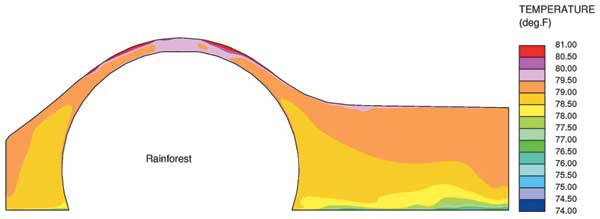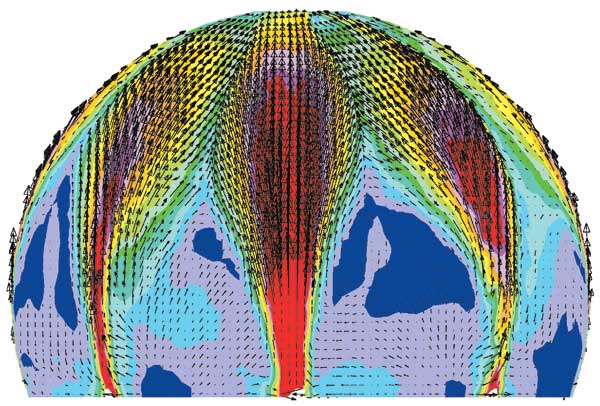BIM Promotes Sustainability
Informing Construction and Operations
The connections between BIM and LEED can be found throughout design and engineering. But sometimes BIM comes into play only after construction has begun. This was the case for the renovation of the Washington, D.C. Constitution Center, designed by SmithGroup and currently under construction by the James G. Davis Construction Corporation. Subcontractors became nervous about installing their equipment in the tightly packed 90,000-square-foot penthouse, so the owner commissioned the architect to model the space. The 3D representation demonstrated that everything would indeed fit-and uncovered a few possible conflicts-giving the subcontractors the confidence to proceed. Making the penthouse taller to accommodate the equipment was not an option "without an act of Congress," says SmithGroup's David Varner, AIA, in reference to the capital city's strict limits on building heights. The model had to show how the equipment could be layered; it was organized so closely that some would become inaccessible after other equipment was installed. Varner recalls: "We have ductwork 4 to 6 feet wide and 3 feet tall, and it's covering up a lot of conduit. We had to show how all that got structured, where the pull boxes go, for instance, and how it could all get suspended without being overly redundant." The process also contributed to the greenness of the building, which is expected to receive a LEED-Silver rating. Varner explains: "Modeling the penthouse has made us more confident that our design intent will be preserved and not compromised in some unforeseen way."

California Academy of Sciences Below: Air speeds are mapped in the domed rainforest exhibition. Images courtesy ARUP |

BIM came to the rescue several years after construction, when the Pittsburgh Convention Center was not performing as well as predicted by architect/engineer Burt Hill. Engineer Rooke explains that it had been designed as a high-performance building, but the owners weren't seeing the expected energy savings. He says: "Using a detailed energy simulation normalized to actual energy usage, I was able to pinpoint some areas that either hadn't been thought of in the design or weren't being operated as intended. After we fixed those, the energy performance of the building improved. This is the tip of the iceberg of how BIM can carry energy information through the life of the building and help owners operate their buildings effectively."
That's been the experience of facilities manager and CAD Manager Clyne Curtis, at Brigham Young University in Provo, Utah. He is in the process of converting their AutoCAD databases into Revit models. In the past, he needed to maintain redundant files for each building: one to show the architectural drawing and another for the polylines used in area calculations. Revit models include both forms of representation, so changes only need to be entered once, reducing the chance of errors. The Revit models contribute to the ongoing energy conservation on campus in several ways. With data exported to Green Building Studio, heat loss and gain can be easily calculated for individual rooms allowing managers to fine-tune the equipment for efficiency and appropriately size air supply and return lines. In this dry climate, concrete surfaces can serve as thermal mass, so the energy analysis, Curtis explains, informs changes to flooring or ceiling materials that can improve comfort in each room.
Although the technology has a long way to go before BIM fulfills all its promises to promote sustainability, pockets of success abound. James Barrett, Turner's national manager of Virtual Construction Technologies, claims that BIM itself is green and worthy of LEED points. First, he argues, BIM results in a huge reduction of paperwork. Also, because subcontractors can reliably predict the amount of material they'll need in the field, they do not need to over-order, which traditionally leads to waste. Barrett asks: "If LEED gives points for recycling waste, why not for avoiding waste?"
The perfect ideal of BIM may not be attainable, but pieces of it are definitely coming together. Projects-and the environment-are benefiting from more cohesive teamwork and a greater degree of interoperability among software systems. Architects are receiving better, earlier energy-related analysis; engineers are providing more focused expertise during design; builders are reducing waste in construction; and facility managers are increasing the efficiency of their operations. And many of those experiencing the benefits of technology and teamwork have visions of still more capabilities and benefits in the future.








